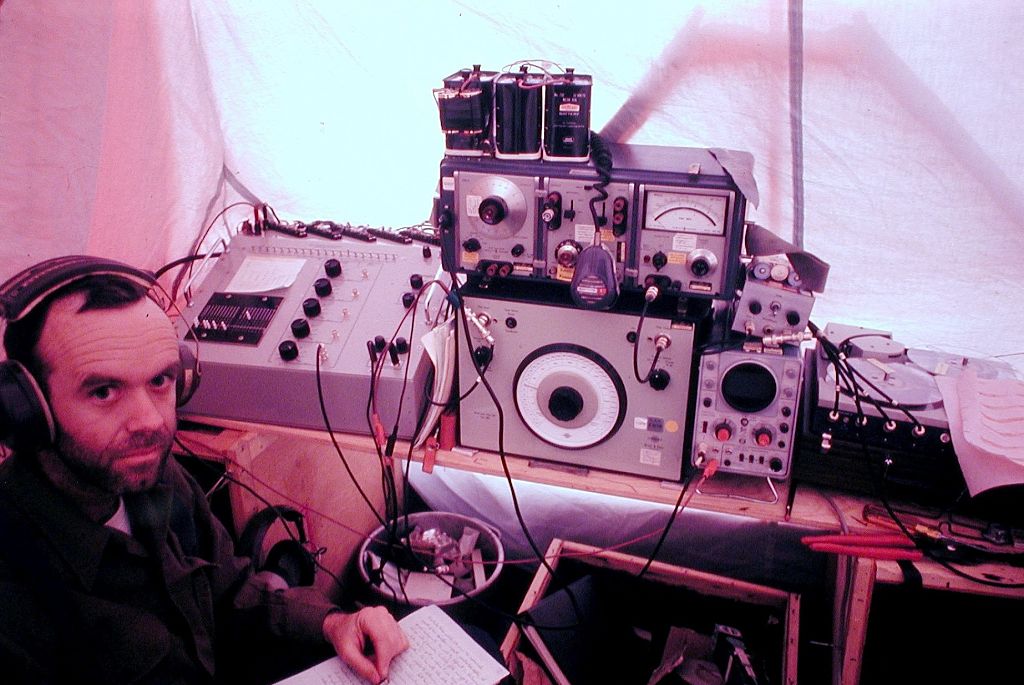Pilot study of beluga-call monitoring in Cook Inlet, Alaska (2004)
 The Alaska office of LGL Limited leveraged the Bioacoustic Probe's ease-of-use to conduct a low-cost pilot study on the feasibility of monitoring beluga whales in Cook Inlet by recording their vocalizations. Bioacoustic Probes were deployed at two underwater locations near Anchorage for several days in September and October 2004. LGL personnel performed all field work, programming, deploying, and recovering the Bioacoustic Probes, while Greeneridge analyzed the recordings for beluga vocalizations and other natural and man-made sounds. The recordings captured a large variety and quantity of beluga calls.
The Alaska office of LGL Limited leveraged the Bioacoustic Probe's ease-of-use to conduct a low-cost pilot study on the feasibility of monitoring beluga whales in Cook Inlet by recording their vocalizations. Bioacoustic Probes were deployed at two underwater locations near Anchorage for several days in September and October 2004. LGL personnel performed all field work, programming, deploying, and recovering the Bioacoustic Probes, while Greeneridge analyzed the recordings for beluga vocalizations and other natural and man-made sounds. The recordings captured a large variety and quantity of beluga calls.
Assessing potential acoustic impact of vibratory pile driving on riverine environments (2003-2004)
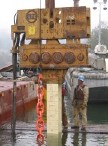 Two projects focused on the potential acoustic impact of vibratory pile driving on salmonid fish in the Duwamish and Snohomish rivers near Seattle, Washington. In the Duwamish project, a land-based vibratory injection system inserted a self-hardening slurry deep into the ground around the perimeter of a former chemical facility on the banks of the Duwamish to prevent contaminants from leaching into the river; vibrations from the injection system propagated through the ground before coupling into the water. In the Snohomish study, an APE 200 vibratory driver drove H-piles directly into the riverbed to reinforce a submerged pipeline. Greeneridge deployed boat-based and autonomous recorders to characterize and compare ambient and driver-related sounds in the rivers as a function of time, depth, and location. The combination of very shallow water with the low acoustic frequencies radiated by the drivers led to unusual distributions of acoustic energy compared with less complex environments. The reports included estimates of potential acoustic impact on salmonids and other riverine wildlife.
Two projects focused on the potential acoustic impact of vibratory pile driving on salmonid fish in the Duwamish and Snohomish rivers near Seattle, Washington. In the Duwamish project, a land-based vibratory injection system inserted a self-hardening slurry deep into the ground around the perimeter of a former chemical facility on the banks of the Duwamish to prevent contaminants from leaching into the river; vibrations from the injection system propagated through the ground before coupling into the water. In the Snohomish study, an APE 200 vibratory driver drove H-piles directly into the riverbed to reinforce a submerged pipeline. Greeneridge deployed boat-based and autonomous recorders to characterize and compare ambient and driver-related sounds in the rivers as a function of time, depth, and location. The combination of very shallow water with the low acoustic frequencies radiated by the drivers led to unusual distributions of acoustic energy compared with less complex environments. The reports included estimates of potential acoustic impact on salmonids and other riverine wildlife.
Monitoring impact pile driving in San Francisco Bay (2002-2003)
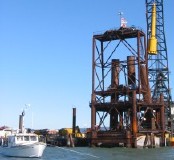 In 2003, the California Department of Transportation (Caltrans) began construction of a new Benicia-Martinez bridge across the Carquinez Strait, followed in 2004 by foundations for the new east span of the San Francisco-Oakland Bay Bridge. The size of the piles driven for these construction projects and the use of impact techniques to drive them introduced potentially significant sound levels into fish habitat of the nation's second-largest estuary. Using a combination of boat-based and autonomous recorders, Greeneridge measured and documented underwater sound levels associated with impact pile driving at these two sites, including comparisons of sound levels with and without bubble curtains and dewatered coffer dams around the piles. Because the sounds of concern were transient pulses rather than continuous noise, analysis and interpretation of the acoustic pulses as to their potential effects on wildlife required specialized techniques tailored for impulsive sound. Greeneridge was able to apply methods similar to those it uses to assess the potential acoustic impact of airgun pulses from marine seismic operations.
In 2003, the California Department of Transportation (Caltrans) began construction of a new Benicia-Martinez bridge across the Carquinez Strait, followed in 2004 by foundations for the new east span of the San Francisco-Oakland Bay Bridge. The size of the piles driven for these construction projects and the use of impact techniques to drive them introduced potentially significant sound levels into fish habitat of the nation's second-largest estuary. Using a combination of boat-based and autonomous recorders, Greeneridge measured and documented underwater sound levels associated with impact pile driving at these two sites, including comparisons of sound levels with and without bubble curtains and dewatered coffer dams around the piles. Because the sounds of concern were transient pulses rather than continuous noise, analysis and interpretation of the acoustic pulses as to their potential effects on wildlife required specialized techniques tailored for impulsive sound. Greeneridge was able to apply methods similar to those it uses to assess the potential acoustic impact of airgun pulses from marine seismic operations.
Acoustic measurements in Cook Inlet, Alaska, during August 2001 (2001-2002)
 Greeneridge conducted a survey of both underwater and airborne sounds in Upper Cook Inlet over a four-day period in summer 2002. Measurements were made at isolated locations frequented by beluga whales, as well as in the Port of Anchorage harbor area, at the approach end of the Elmendorf AFB, at the departure end of an active runway at Anchorage International Airport, and near an oil production platform. The report presented the spectra of both background and man-made sounds in relation to measured hearing sensitivities of beluga whales.
Greeneridge conducted a survey of both underwater and airborne sounds in Upper Cook Inlet over a four-day period in summer 2002. Measurements were made at isolated locations frequented by beluga whales, as well as in the Port of Anchorage harbor area, at the approach end of the Elmendorf AFB, at the departure end of an active runway at Anchorage International Airport, and near an oil production platform. The report presented the spectra of both background and man-made sounds in relation to measured hearing sensitivities of beluga whales.
Development of a directional animal monitoring system (DAMS) and application in shock trials of the USS Winston S. Churchill, DDG-81 (2000-2001)
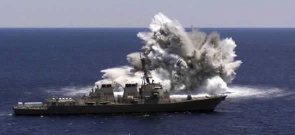 The Navy tests the first ship in every new vessel class for its response to the underwater shock from a near-miss explosion. Because these tests produce considerable acoustic energy, extensive pre-event monitoring for the presence of protected species is required. For the shock trials of the USS Winston S. Churchill in May and June 2001, Greeneridge developed and applied DIFAR-based equipment to detect calls from several protected species, including northern right whales, sperm, sei, blue, humpback, and fin whales.
The Navy tests the first ship in every new vessel class for its response to the underwater shock from a near-miss explosion. Because these tests produce considerable acoustic energy, extensive pre-event monitoring for the presence of protected species is required. For the shock trials of the USS Winston S. Churchill in May and June 2001, Greeneridge developed and applied DIFAR-based equipment to detect calls from several protected species, including northern right whales, sperm, sei, blue, humpback, and fin whales.  Operated from a Navy P3 aircraft, the system combined data from a hexagonal array of DIFAR sonobuoys to detect underwater vocalizations of protected species within a three-mile radius from the planned shot point. Sperm whales were heard, localized, and seen from the aircraft during tests east of Norfolk in April 2001. During the shock trials, no whales were heard or seen, and none was found to have been injured or killed by the explosions. (Churchill photograph from the USS Winston S. Churchill web site, courtesy of the U.S. Navy)
Operated from a Navy P3 aircraft, the system combined data from a hexagonal array of DIFAR sonobuoys to detect underwater vocalizations of protected species within a three-mile radius from the planned shot point. Sperm whales were heard, localized, and seen from the aircraft during tests east of Norfolk in April 2001. During the shock trials, no whales were heard or seen, and none was found to have been injured or killed by the explosions. (Churchill photograph from the USS Winston S. Churchill web site, courtesy of the U.S. Navy)
Monitoring effects of seismic exploration on marine mammals in the Alaskan Beaufort Sea (1996-2002)
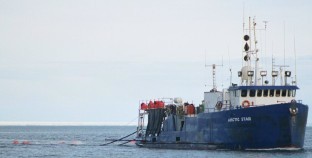 Each year from 1996 through 2001, LGL Limited and Greeneridge monitored effects of seismic exploration programs and (in some years) shallow hazards surveys for BP Exploration (Alaska) Inc. (1996-97), WesternGeco LLC (1998-2001), and the Alaska Gas Pipeline Producers Team (2001). Marine mammal and acoustical monitoring programs were conducted each year, including (in 1996-98) intensive aerial surveys. These studies provided the basis for implementing mitigation measures required to satisfy permit requirements and to assess potential impacts on subsistence hunting. The work also provided considerable new information regarding the behavior of whales and seals exposed to airguns and other acoustic sources. Migrating bowheads were found to deflect their migration route at considerable distances from an airgun array, and distanced themselves from it while it was operating. These projects required close coordination with Inupiat whalers and employed Inupiat as shipboard observers.
Each year from 1996 through 2001, LGL Limited and Greeneridge monitored effects of seismic exploration programs and (in some years) shallow hazards surveys for BP Exploration (Alaska) Inc. (1996-97), WesternGeco LLC (1998-2001), and the Alaska Gas Pipeline Producers Team (2001). Marine mammal and acoustical monitoring programs were conducted each year, including (in 1996-98) intensive aerial surveys. These studies provided the basis for implementing mitigation measures required to satisfy permit requirements and to assess potential impacts on subsistence hunting. The work also provided considerable new information regarding the behavior of whales and seals exposed to airguns and other acoustic sources. Migrating bowheads were found to deflect their migration route at considerable distances from an airgun array, and distanced themselves from it while it was operating. These projects required close coordination with Inupiat whalers and employed Inupiat as shipboard observers.
Research on bowhead and beluga whale responses to playback sounds during spring migration northeast of Barrow, Alaska (1989-1991 and 1994)
Greeneridge and LGL Limited established temporary research stations on the sea ice during April and May during each of the four spring seasons studied. Sounds of ice-founded drilling and an operating icebreaker were played back underwater in controlled experiments while biologists studied whale behavior from a fixed wing aircraft. Greeneridge also measured background sounds and sound propagation loss from these ice stations.
Documenting sounds and whales near drillships in the Alaskan Beaufort Sea (1985-1986)
Greeneridge used moored buoys with radio telemetry to a support ship to monitor and record bowhead whales near drillships performing exploratory drilling during fall bowhead migration. Bowhead locations were calculated using passive acoustics (hyperbolic localization) on the whale vocalizations. Underwater sounds from the industrial operations were also documented. Sonobuoys from survey aircraft were used to monitor more distant whales.
Documenting sounds near artificial islands during exploratory drilling in the Alaskan Beaufort Sea (1984-85)
Greeneridge measured and reported on the underwater sounds from Seal Island (1984) and Sandpiper Island (1985) during the fall bowhead migrations. Cabled hydrophones from the islands and sonobuoys from whale survey aircraft sensed the sounds.
Documenting sounds and whales near ice edges in Lancaster Sound and Admiralty Inlet (1982-1983)
Prior to establishing Greeneridge, Dr. Charles Greene performed the acoustics field work, analysis, and reporting for this research under subcontract to LGL Limited. Beluga whales and narwhals were visually observed to avoid an icebreaking ore carrier and Canadian Coast Guard icebreakers. Underwater sounds of both the whales and the ships were recorded and documented with hydrophones suspended through holes in the shore-fast ice.
Documenting sounds and whales near oil and gas exploration operations in the Canadian Beaufort Sea (1980-1984)
Dr. Charles Greene performed the acoustics field work, analysis, and reporting for this research project under subcontract to LGL Limited. Field work spanned about six weeks every summer for five years. Both bowhead and beluga whale sounds underwater were studied. Using a cabled hydrophone about 1 km from shore, calls were recorded from beluga whales swimming along the Yukon Coast. Industry operations from helicopters, dredges, drillships and platforms, and numerous vessels were also recorded. Sensors included sonobuoys deployed from study aircraft and hydrophones deployed from boats. A sound projector and small airgun were used for playback experiments.

